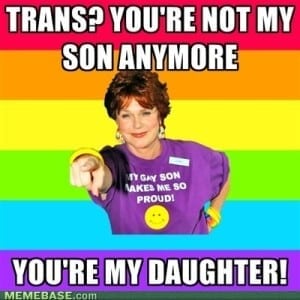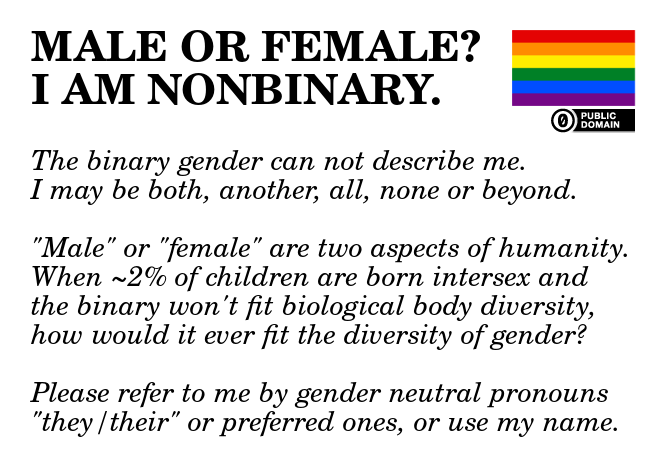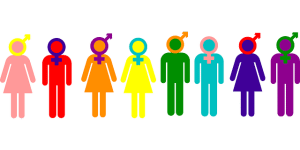I don’t claim to know everything (unless it’s about sexuality or flavors of Burnett’s), and I don’t expect our readers to either. Vocabulary, particularly regarding social issues, is one of those tough subjects.
There are tons of different terms when it comes to sexuality and gender; more than just straight/gay and male/female. Sometimes I feel like I’m all caught up on terminology, just to hear a new term again! As a result, I want to define some common and confusing terms for you, so we can all be more educated world citizens.
Sex vs. Gender
What’s the difference between sex and gender? “Sex refers to the biological distinction between males and females”, so physical, anatomical characteristics and differences. By contrast, “gender concerns the social differences between males and females.”, so perceived personality traits, societal roles, and social norms. (Definition from Chegg.com)
Inclusive Language
Inclusive language is the idea of not using gendered pronouns such as he, she, his, hers or anything else that assumes someone’s gender. The safest way to do this when speaking hypothetically, writing, and addressing a group of people is to use the word “they” instead.
For example: “Students should leave their keys at the desk before leaving.” As compared to, “Each student should leave his or her key at the desk before leaving.” (from the University of Aberdeen) The second sentence, though including his and her, does not cater to people who don’t identify with either pronoun.
Because using “they” is not always a preferred option in conversation, new pronouns have been created to combat this. This pronouns are “Ze, Hir, Hirs” (pronounced zee, here, heres). These words are considered gender neutral, though they are not commonly used in conversation. Emily Bauer of Carleton College has put together a chart you can consult if you are grammatically confused on the use of these words.
Ask people what they prefer.
(It’s easier than you think!)
- Kick things off by asking: “Do you have a preferred pronoun?”
- Recognize that while this may confuse some people, it’s also an awesome opportunity to explain why you’re doing it, and it will really mean something to those who have been mis-identified or care about the issue.
- Don’t expect that if you ask once, it’s set forever. People’s gender identities can change!
- One great way to ask for preferred pronouns is to incorporate preferred pronoun into introductions, particularly in student organization meetings. For example, you could say, “Hey, I’m Schiller, I’m from Germany, I’m a super-senior, English and Philosophy double major and my preferred pronouns are he/him.” (Bauer)
Definitions of Terms
Sexual Orientation
“Sexual Orientation: the type of sexual, romantic, physical, and/or spiritual attraction one feels for others, often labeled based on the gender relationship between the person and the people they are attracted to; often mistakenly referred to as “sexual preference”
“Asexual: a person who generally does not experience sexual attraction (or very little) to any group of people”
“Bisexual: a person who experiences sexual, romantic, physical, and/or spiritual attraction to people of their own gender as well as another gender; often confused for and used in place of “pansexual”
“Gay: a term used to describe a man who is attracted to men, but often used and embraced by women to describe their same-sex relationships as well”
“Heterosexual: a medical definition for a person who is attracted to someone with the other gender (or, literally, biological sex) than they have; often referred to as “straight”
“Homosexual: a medical definition for a person who is attracted to someone with the same gender (or, literally, biological sex) they have, this is considered an offensive/stigmatizing term by many members of the queer community; often used incorrectly in place of “lesbian” or “gay”
“Pansexual: a person who experiences sexual, romantic, physical, and/or spiritual attraction for members of all gender identities/expressions”
“Queer: (1) historically, this was a derogatory slang term used to identify LGBTQ+ people; (2) a term that has been embraced and reclaimed by the LGBTQ+ community as a symbol of pride, representing all individuals who fall out of the gender and sexuality “norms”
“Questioning: the process of exploring one’s own sexual orientation, investigating influences that may come from their family, religious upbringing, and internal motivations”
“Same Gender Loving (SGL): a phrase coined by the African American/Black queer communities used as an alternative for “gay” and “lesbian” by people who may see those as terms of the White queer community.”
“Skoliosexual: attracted to genderqueer and transgender people and expressions (people who aren’t identified as cisgender)”
*all definitions come from this AWESOME article here.
Gender Terms
“Gender Identity: the internal perception of an individual’s gender, and how they label themselves”
“Gender Expression: the external display of gender, through a combination of dress, demeanor, social behavior, and other factors, generally measured on a scale of masculinity and femininity”
“Androgyny: (1) a gender expression that has elements of both masculinity and femininity; (2) occasionally used in place of “intersex” to describe a person with both female and male anatomy.”
“Bigender: a person who fluctuates between traditionally “woman” and “man” gender-based behavior and identities, identifying with both genders (and sometimes a third gender)”
“Binary Gender: a traditional and outdated view of gender, limiting possibilities to “man” and “woman”
“Cisgender: a description for a person whose gender identity, gender expression, and biological sex all align (e.g., man, masculine, and male)”
“Cis-man: a person who identifies as a man, presents himself masculinely, and has male biological sex, often referred to as simply “man”
“Cis-woman: a person who identifies as a woman, presents herself femininely, and has female biological sex, often referred to as simply “woman”
“Fluid(ity): generally with another term attached, like gender-fluid or fluid-sexuality, fluid(ity) describes an identity that is a fluctuating mix of the options available (e.g., man and woman, gay and straight); not to be confused with “transitioning”
“Genderless: a person who does not identify with any gender”
“Genderqueer: (1) a blanket term used to describe people whose gender falls outside of the gender binary; (2) a person who identifies as both a man and a woman, or as neither a man nor a woman; often used in exchange with “transgender”
“Intersex: a person with a set of sexual anatomy that doesn’t fit within the labels of female or male (e.g., 47,XXY phenotype, uterus and penis)”
“Third Gender: (1) a person who does not identify with the traditional genders of “man” or “woman,” but identifies with another gender; (2) the gender category available in societies that recognize three or more genders”
“Transgender: a term used to describe people who are not cisgender; occasionally used as “transgendered” but the “ed” is misleading, as it implies something happened to the person to make them transgender, which is not the case”
“Transitioning: a term used to describe the process of moving from one sex/gender to another, sometimes this is done by hormone or surgical treatments”
“Transsexual: a person whose gender identity is the binary opposite of their biological sex, who may undergo medical treatments to change their biological sex, often times to align it with their gender identity, or they may live their lives as the opposite sex; often confused with “trans-man”/”trans-woman”. This term can be offensive. Others may use the word transgender instead.
“Transvestite: a person who dresses as the binary opposite gender expression (“cross-dresses”) for any one of many reasons, including relaxation, fun, and sexual gratification; often called a “cross-dresser,” and often confused with “transsexual”. This term can be offensive.
“Trans-man: a person who was assigned a female sex at birth, but identifies as a man; often confused with “transsexual man” or “FTM”
“Trans-woman: a person who was assigned a male sex at birth, but identifies as a woman; often confused with “transsexual woman” or “MTF”
“Two-Spirit: a term traditionally used by Native American people to recognize individuals who possess qualities or fulfill roles of both genders”
*all definitions come from this AWESOME article here.

I hope I’ve cleared things up for you, dear internet friends.
Note from the author: If I got something wrong or you don’t feel your identify was represented, please comment! I’d love to hear from you.








7 articles posted and I still am not used to seeing my (pen) name in print. I swear, it’s just as exciting every time!
ALL OF THE YAAAASSSS!!!!!!
I’m so excited to see something like this on the site! Even when people are aware of all the varying identities that people feel comfortable identifying with, it’s so often overlooked when it comes to our everyday speech (and writing) and putting our knowledge into use/practice: something that I know I’m personally guilty of as well.
So excited about this article! Congratulations this is no doubt my favorite one of your pieces! I often find it difficult to write informative pieces while trying to keep everything interesting and the reader engaged. You clearly had no difficulty accomplishing that with this piece!
Sapiosexual: A behavior of becoming attracted to or aroused by intelligence and its use.
This may not be as controversial as many other sexual orientations, but I believe it to be noteworthy. I consider it to be my romantic orientation although not always my sexual orientation.
Yesssss that’s awesome!
Absolutely love this, there always in a je ne sais quoi about intelligent people, thanks for giving it a name!
Personally I always thought that transsexual was a more derogatory term to replace transgender. One suggestion I would make is that “genderless” is actually “agender,” which would be a person who lacks a definitive gender. I love that this post is even on here; it means a lot to us nonbinary folks. It’s difficult to unlearn the negative way of regarding gender we’ve been instilled with, but posts like this on such highly trafficked sites helps to spread the word to people who may not find out otherwise. The biggest thing to remember is inclusive language, and this post accurately addresses it! Thank you for this great article!
Actually, i would like to say that for asexuality : there’s many degrees for the Spectrum of Asexuality 😛
The list is long.
Theres some ppl who are sex-repulsed ace, others gray-ace/demisexual ^^
You can check AVEN website, its a really good website, complete and all for the spectrum of asexuality ^^
Peace sis’ or bro, or comrade, like u want !
^^
I have been searching for a post such as this for a very long moment.
When I was a school student, I thought just how one ought to tackle this matter but I’d constantly come across some questionable answers: go google it or even ask a friend. What if my friends don’t have sufficient knowledge or experience to help me? Imagine if I googled it multiple times and could not find the solution? That’s when posts like this you can give proper guidance on the problem.
This blog is very informative for me and also helpful to know about sex toys.